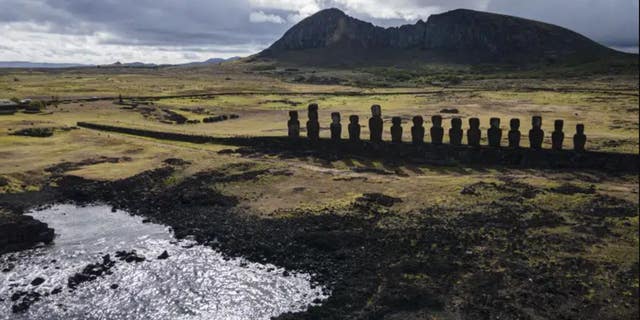Scientists have found a previously unknown moai, monolithic human figures carved by the Rapa Nui people on Easter Island, in a dry lake bed on the small island in the middle of the Pacific.
Geologists were studying the site after fires swept through the area last year. It could mean that more figures and tools used by the Rapa Nui natives are buried nearby at the once underwater site, the scientists said.
“This is the first time, as far as I understand, that anything has been found in the basin,” said archaeologist Jose Miguel Ramirez.
EASTER ISLAND STILL RECOVERING FROM OCTOBER FIRE THAT DAMAGED MOAI STATUES
It meant that “probably the lake had dried up at some point in the past, and perhaps the Rapa Nui were taking the opportunity to move the statue,” he added.
“I think more moai will continue to show up,” Ramirez said.

Moai statues are found on Ahu Tongariki near the Rano Raraku volcano, high up, in Rapa Nui, or Easter Island, Chile, November 27, 2022. According to Salvador Atan Hito, vice president of the Ma’u Henua indigenous community which administers the archaeological treasure of Rapa Nui, March 1, 2023, a small moai was recently discovered in the middle of a dry lagoon inside the crater of the volcano. (AP Photo/Esteban Felix, Files)
Easter Island, a Chilean territory about 2,200 miles from the mainland, is a protected national park and a UNESCO World Heritage Site. Researchers believe that the island’s first inhabitants arrived more than 1,000 years ago, and its famous monolithic human figures were erected around 400 to 700 years ago.
EASTER ISLAND DISCOVERY: EXPERTS SHEND NEW LIGHT ON THE MYSTERY OF CIVILIZATION’S “COLLAPSE”
“What we saw today is very important, because it is part of the history of the Rapa Nui people,” said Salvador Atan Hito, a leader of the Ma’u Henua indigenous community who oversees the site.
The half-buried 5-foot moai will now undergo tests to determine what state it is in, the researchers said. As Easter Island is littered with hundreds of towering stone heads, they face threats from the elements, including the fires that led to this statue’s uncovering.
CLICK HERE TO GET THE FOX NEWS APP
Reuters contributed to this report
